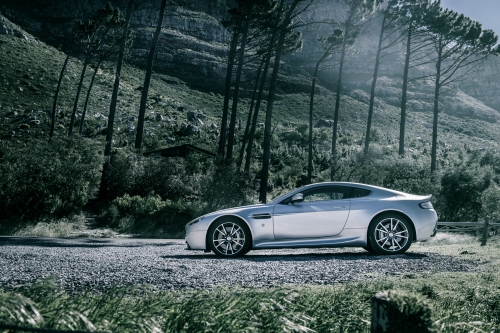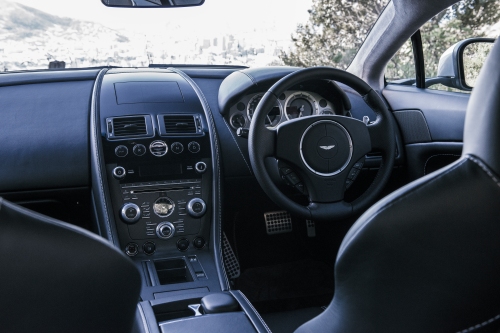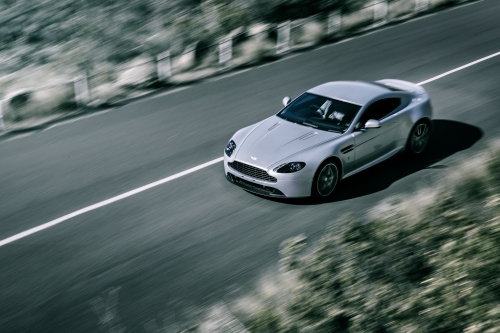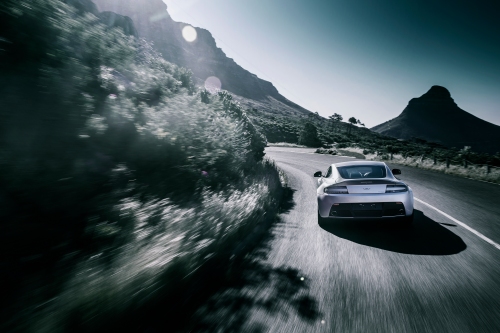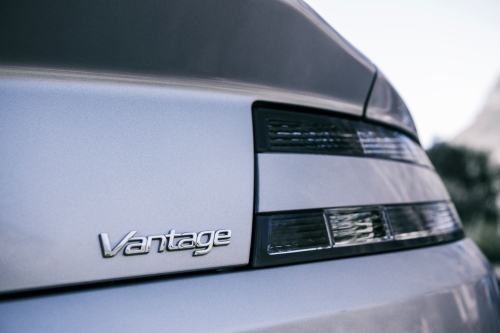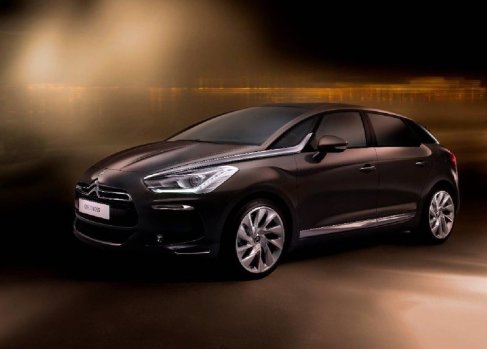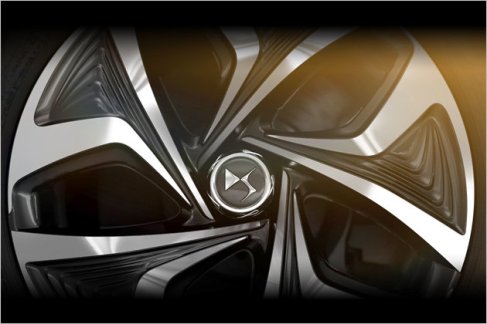IT’S HARD NOT to get just remotely excited when the key to an Aston Martin for evaluation lands on your desk. Of life’s many pleasures there’s nothing as fulfilling as shepherding a thoroughbred sports car through a series of tightly knitted corners, all to the glorious tune of an unsullied V8 mill. The key I’m holding, however, doesn’t belong to the latest Vanquish but rather the new Vantage V8 – one of the most successful Aston’s ever made. Yep, it may be over seven years old now but Aston Martin has parlayed various components from last year’s Vantage S into the model you see here, resulting in a more focussed and surprisingly cheaper car than before. Nevertheless, can the Vantage V8 still cut it as a modern sports car?
In the metal
Although the Vantage is getting on in years, it still cuts an exquisite shape, particularly when parked against the picturesque rock-strewn backdrop of Table Mountain. There aren’t many cars that exhibit the same sense of balance, beauty and poise. The classical contoured silhouette with short front and rear overhangs, bulky haunches and hunkered stance all evoke a sense of speed even when it’s not moving – it’s achingly beautiful. The 2012 model has inherited a number of styling riffs from the Vantage S and the results are rather impressive to say the least. Aston’s fabled grille layout punctuates the front end flanked by newly-designed headlight clusters complete with intricate LED accenting while a lower front bumper with pronounced air dams and a splitter have injected the Brit with a refined level of aggression and undeniable road presence. As you move along the car’s shoulder line towards the rear, you’ll notice the chunkier side skirts and a larger rear diffuser which complete the visual package.
Life inside
As expected, the cabin features a contrasting meld of hand-crafted equipment and plush cow hide and Alcantara, resulting in a comfortable and cocooning cockpit. Of course, the interior is fairly customisable and can be personalised with complementary stitching, more leather and facia accents but our test car was pretty standard from a trim-spec point of view. Still, the relationship between the leather and aluminium switchgear on offer is of a premium feel, the only disappointments being the audio unit and the integrated pop-up Garmin navigation screen, which both look out of place amid the other equipment’s high-quality fit and finish. The seats may not quite match the grippy nature of a Porsche bucket seat but they’re still first-grade items, and the high scuttle line gives the illusion that you’re sitting just millimetres off the road surface – proper race car stuff. Like all automatic Aston Martins, the interior is bereft of a traditional gear lever. Four buttons assume the role of gear selectors instead and inhabit the space just above the audio toggles on the facia, marked Sport, Neutral, Reverse and Drive.
In the hot seat
The same high-revving 4.7-litre V8 engine introduced during the last round of updates has been retained and fills the space behind the front wheels. Power and torque outputs are unchanged at 313kW and 470Nm respectively. The only powertrain alteration comes in the form of a new seven-speed automated manual gearbox that has been passed down from the Vantage S. Sure, this transmission has its benefits – according to Aston Martin the ratios are shorter and shifts are quicker, but in reality the gear changes feel stilted and incoherent. The terrible shift sensation can be minimised by coming off throttle during up-changes but this feels unnatural and counter intuitive, and does nothing but amplify the disconnection between engine and transmission. As a result you never really bond with the car in the same manner as you would a car with a traditional manual or even a dual-clutch transmission. But perhaps I’m being too harsh here because the gearbox does have its perks: it’s just as happy trundling around town at low speeds as it is butchering the red line, and the fuel consumption figure isn’t too bad, either. I managed to eke out an impressive 10.9ℓ/100km over our economy run but not without some serious restraint from my trigger-happy right foot.
Performance levels are surprisingly a little on the tepid side. The brochure claims a 4.9sec 0-100kph time but we couldn’t get it to dip under the magical five-second barrier, no matter how hard we tried. The best we could muster was 5.3 seconds with a 13.35 quarter mile, which are both quite a way off the figures logged by the Porsche Boxster S we recently put through its paces. Bugbears aside, the big V8 does discharge quite a spectacular noise especially when the bypass valves open their mandibles at 4000rpm, not to mention the flurry of spine-tingling blips that accompany each downshift.
An asphalt rollercoaster
The Vantage makes up for the lacklustre straight-line stuff the moment you flick its nose into a corner. It’s phenomenally responsive in the twisties. The 49:51 front/rear weight distribution means the car remains neutral in most cornering situations so there’s no understeer – even oversteer feels oddly in check as the fatter rear wheels foster unbelievable grip levels as they embrace the bitumen beneath. The new Vantage also gets the steering column, re-valved power-steering pump and quicker steering ratio (15:1 instead of 17:1) from the S. There’s real positivity to the steering, it’s superbly weighted with detailed feedback instilling a sense of confidence that allows the driver to be more creative with steering inputs. And creative I was – the road directly beneath Table Mountain offers a varying surface with tight directional changes and the Vantage’s suspension absorbed the imperfections and kept its shape through some of the bumpier transitions even with as much as 70% throttle applied. The only real let-down, if I were to nitpick, is the thin steering wheel, which lacks the girth and meaty feel of a Porsche or Mercedes-Benz AMG equivalent.
Final call
The Vantage is still a great driver’s car – no question about it, but realistically it poses no threat for the newer and more technologically advanced Porsche 911Carrera S. The competition has moved on significantly during the last couple of years whereas Aston hasn’t, choosing to instead reinvent (read recycle) an aging product portfolio. Personally though, the only real issue I have with the Vantage is the inarticulate automated transmission, which tarnishes the entire driving process and robs the driver from ultimate involvement. Sure, I understand that certain global markets demand the services of an autobox, but why anyone would prefer it over a razor-sharp dual-clutch transmission is seriously perplexing.
Make no mistake, the Vantage is still one beautiful machine, an icon of timeless design many admirers, including myself, hold in the same company as legends such as the Jaguar E-Type and Ferrari 250 GTO. From a pricing viewpoint, Aston has had to slash its sticker price by R100000 to level the showroom playing fields so to speak, but at R1720000 it’s still over half-a-million more expensive than the 911 Carrera S – yikes! One thing is for sure though, the Vantage is still the most alluring and well-proportioned sports car currently on the market, and because of its huge status appeal (and now cheaper asking price) it will continue to sell and beguile the buying public, even with faster and cheaper opposition entering the fray.
Follow me on Twitter @AaronBorrill
